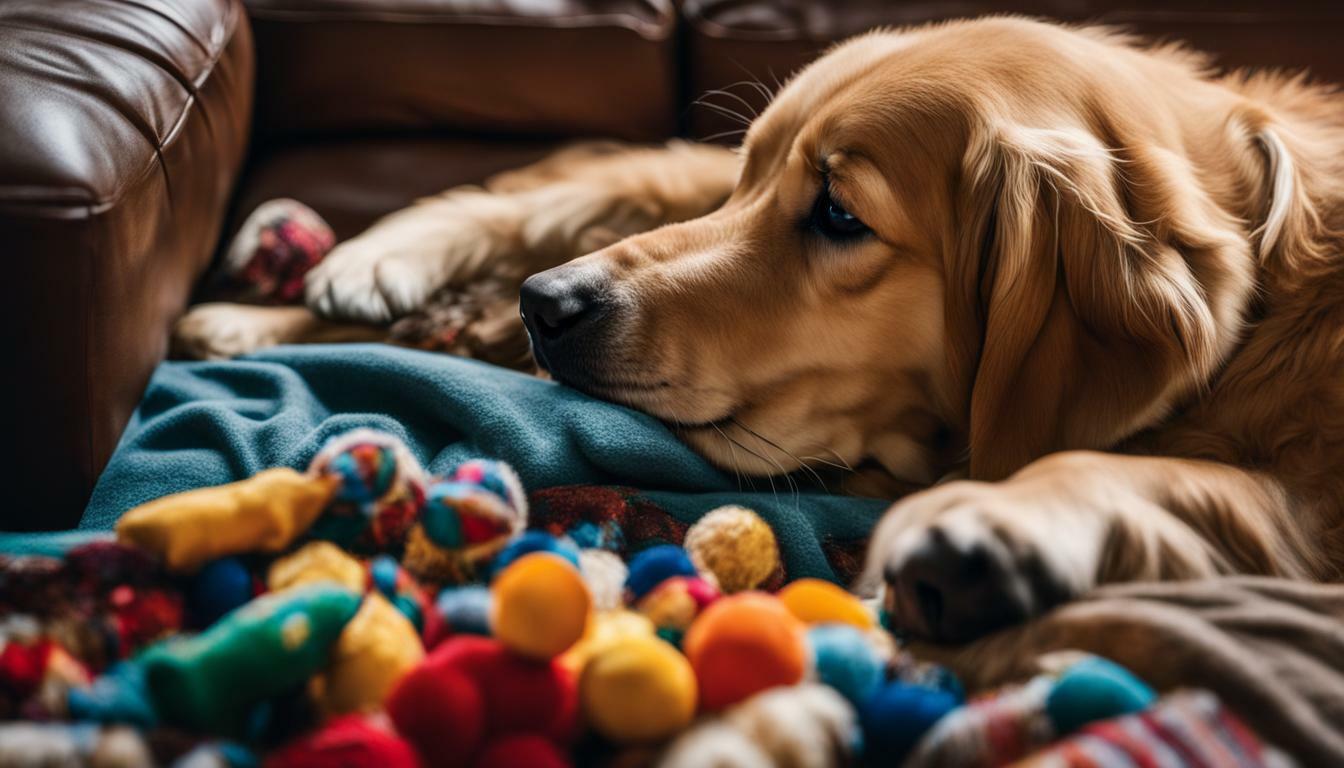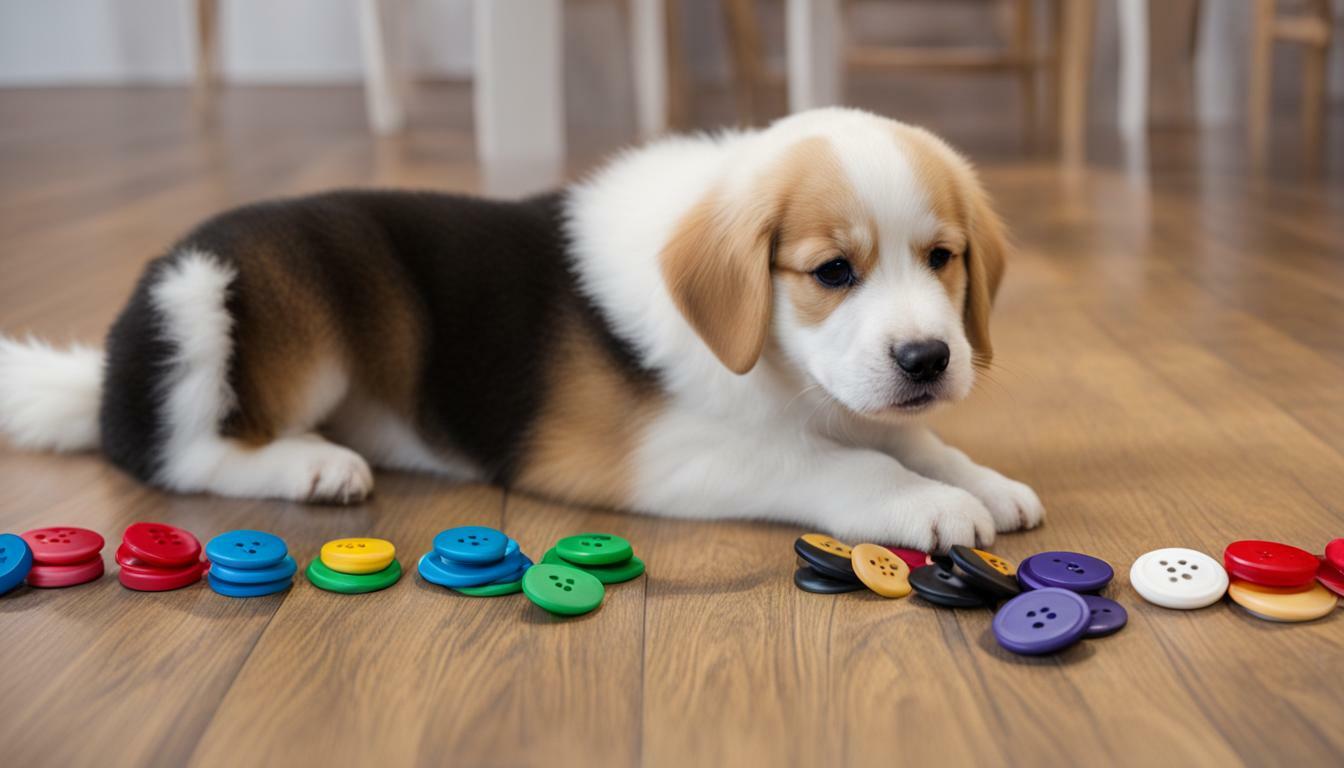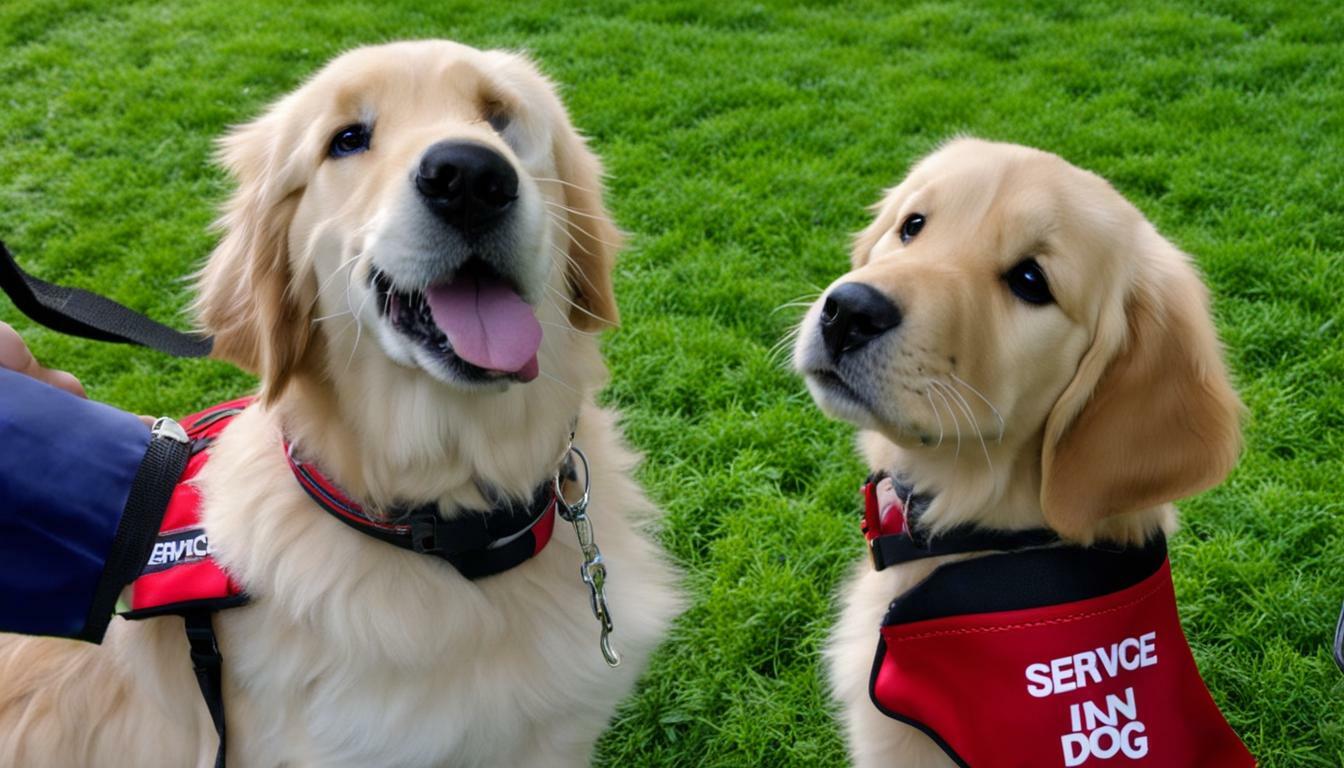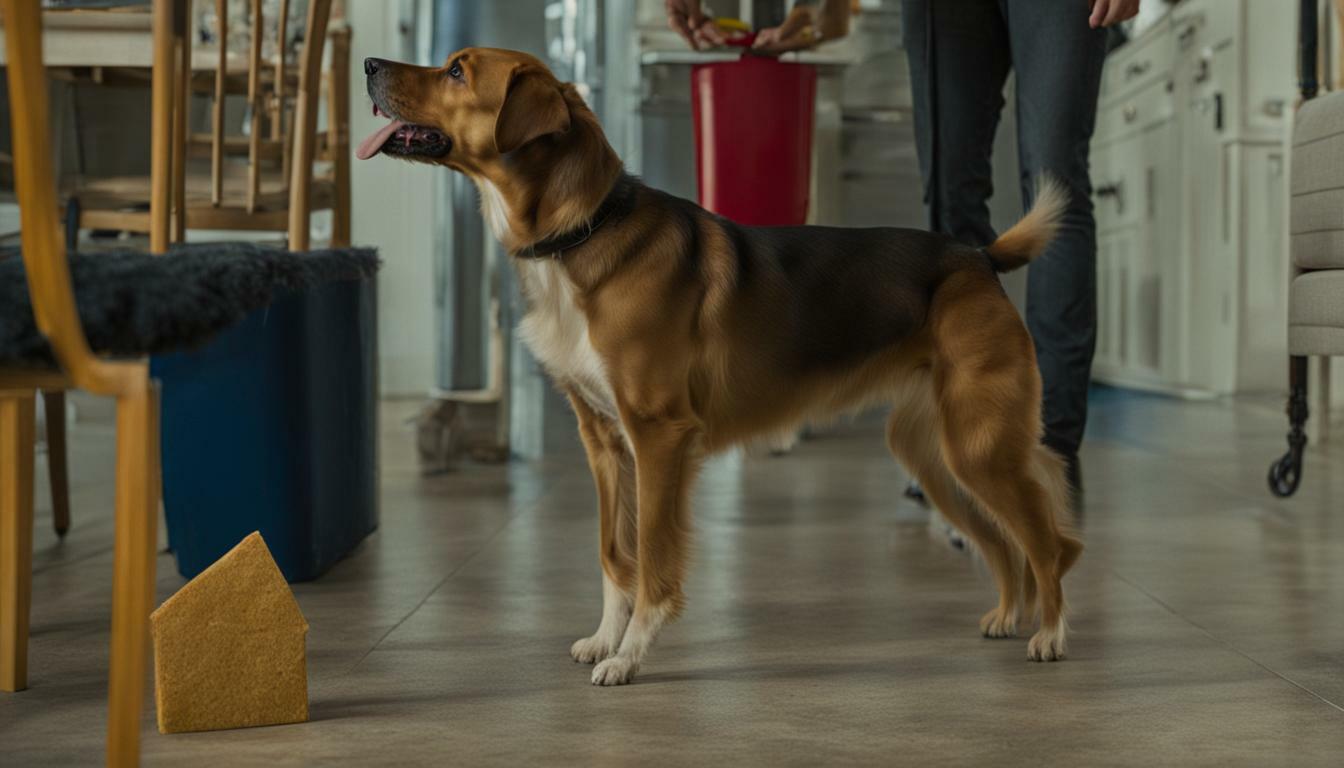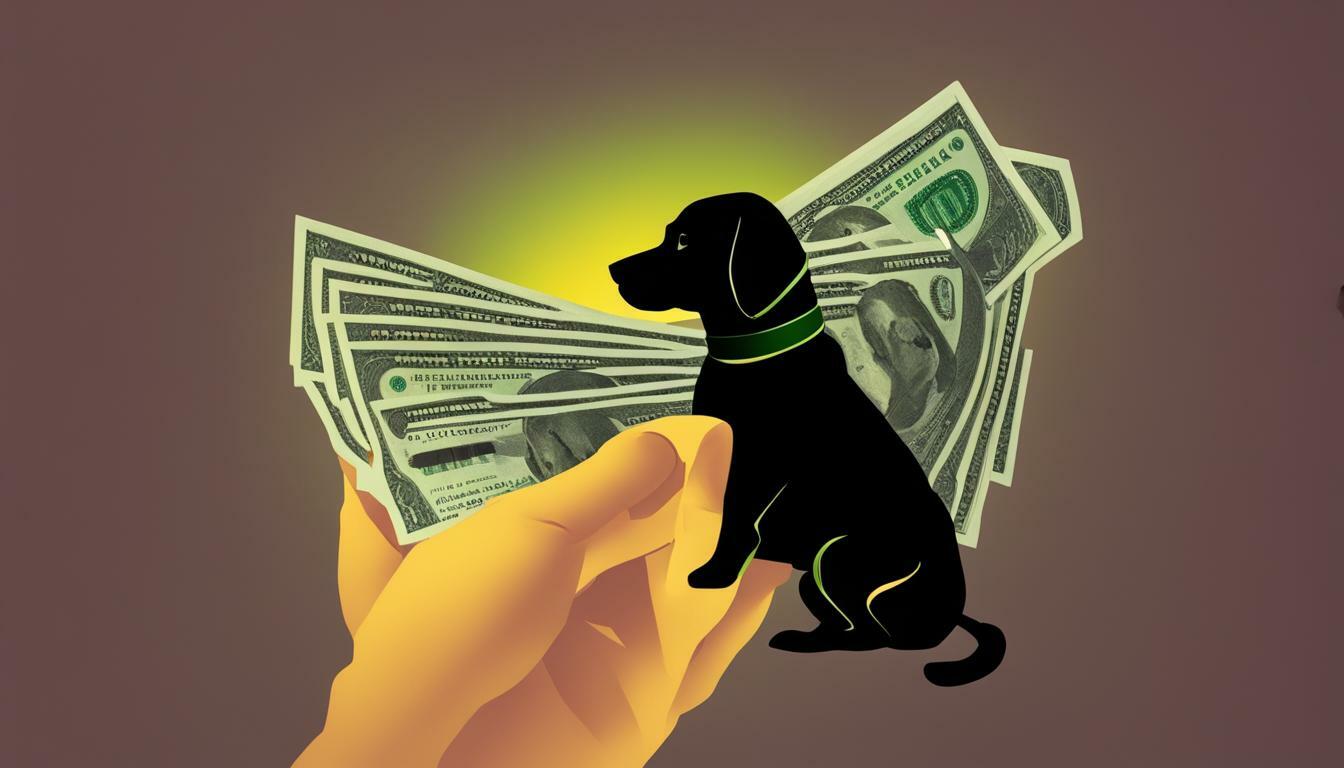Training your dog to detect anxiety can be a rewarding experience for both you and your furry companion. Not only can it strengthen your bond, but it can also provide you with emotional support and alert you to potential anxiety triggers. By following our step-by-step guide, you can teach your dog to detect anxiety cues and be there for you when you need it most.
- Training your dog to detect anxiety can improve your bond and your mental health.
- Understanding how dogs detect emotional distress is important before starting training.
- Choosing the right dog for anxiety detection training is crucial.
- Creating a positive training environment and using positive reinforcement is essential.
- Training exercises and fine-tuning skills can enhance your dog’s ability to detect anxiety cues.
Understanding Anxiety Detection in Dogs
Dogs have a remarkable ability to detect subtle changes in the environment, including emotional distress. They can sense changes in body language, breathing patterns, and even scent. These natural abilities make them ideal candidates for anxiety detection training.
Canine anxiety detection training techniques involve teaching dogs to identify and respond to anxiety signals. This can include changes in behavior, vocalizations, and physical symptoms. By detecting these cues, trained dogs can provide emotional support to their owners and help them manage their anxiety.
Researchers believe that dogs can detect changes in human scent when someone is experiencing emotional distress. Studies have shown that dogs can detect the smell of certain chemicals and hormones that are released when someone is anxious or stressed.
Additionally, dogs are highly in-tune with their owner’s behavior and body language. They can pick up on subtle cues, such as a change in breathing or posture, that may indicate anxiety. For example, a dog may notice that their owner is fidgeting or avoiding eye contact, which could indicate anxiety.
Overall, understanding the natural abilities of dogs in anxiety detection is essential for effective training. By working with your dog’s innate senses and instincts, you can teach them to detect anxiety signals and provide you with the support you need.

Training your dog to detect anxiety can provide numerous benefits and help improve your daily life. With the right training techniques for anxiety detection in dogs, your furry companion can become an invaluable asset in managing anxiety and providing emotional support. Here are some of the main benefits of teaching a dog to detect anxiety:
- Alerting to potential anxiety triggers: A well-trained anxiety detection dog can alert you to potential anxiety triggers before they escalate, giving you time to take preventive measures.
- Providing emotional support: Having a dog that can detect anxiety and offer comfort can help boost your mood and reduce feelings of stress and anxiety.
- Increased sense of security: Knowing that your dog is trained to detect anxiety can give you a greater sense of security and support in managing feelings of anxiety.
- Improved bond with your dog: Training your dog to detect anxiety can deepen the bond between you and your pet while providing a shared sense of purpose and accomplishment.
By employing effective methods for teaching a dog to detect anxiety, you can enjoy these benefits and more. Keep reading to learn about the steps to train a dog in anxiety detection and the best techniques to make the most of this invaluable skill.
Choosing the Right Dog for Anxiety Detection Training
Training a dog to detect anxiety requires a certain type of temperament and personality. Not every dog is suited for this specialized training. Here are some steps to consider when selecting a dog for anxiety detection training:
| Step | Description |
|---|---|
| Step 1 | Choose a dog breed that is known for being calm, affectionate, and gentle. Breeds such as Golden Retrievers, Labrador Retrievers, and Poodles are often used as anxiety detection dogs due to their friendly and trainable nature. |
| Step 2 | Consider the dog’s age and health. Training a puppy is generally easier than an adult dog as they are more adaptable and have not yet developed any undesirable behavioral patterns. Additionally, make sure the dog is in good health and able to undergo training. |
| Step 3 | Assess the dog’s personality. Look for a dog that is laid-back, not easily excitable, and comfortable around people. Avoid dogs that are aggressive or easily frightened as they may not be suitable for anxiety detection training. |
| Step 4 | Consider the dog’s training background. Look for dogs that have undergone basic obedience training, as this will make them more receptive to anxiety detection training. |
Once you have chosen your dog, it’s important to prepare them for the training process. This involves building a strong bond with your dog through regular exercise, positive reinforcement, and consistent obedience training. You should also schedule regular visits to the veterinarian to ensure your dog is in good physical health before beginning any training.

- Choose a breed known for being calm, affectionate, and trainable.
- Consider the dog’s age, health, and personality.
- Look for dogs that have undergone basic obedience training.
- Prepare your dog for training by building a strong bond with regular exercise, positive reinforcement, and consistent obedience training.
Establishing a Positive Training Environment
Creating a comfortable and stress-free environment is crucial for effective anxiety detection training in dogs. Start by designating a specific area for training that is quiet and free from distractions. This will help your canine companion to focus and remain calm during training sessions.
Make sure that your dog is in a comfortable physical state before beginning training. This means that their basic needs, such as food, water, and exercise, should be met. Avoid training if your dog is overly tired, hungry, or has not had adequate exercise.
During training sessions, ensure that you remain calm and relaxed. Dogs are incredibly intuitive and can easily pick up on their owner’s emotions. If you’re anxious or stressed, your dog may become anxious or stressed too. Speak in a calm and reassuring tone to help your dog feel secure.
It’s also important to establish a routine for training. Consistency is key when it comes to dog anxiety training, so set aside a specific time each day for training sessions. This will help your dog to establish a routine and understand what is expected of them.
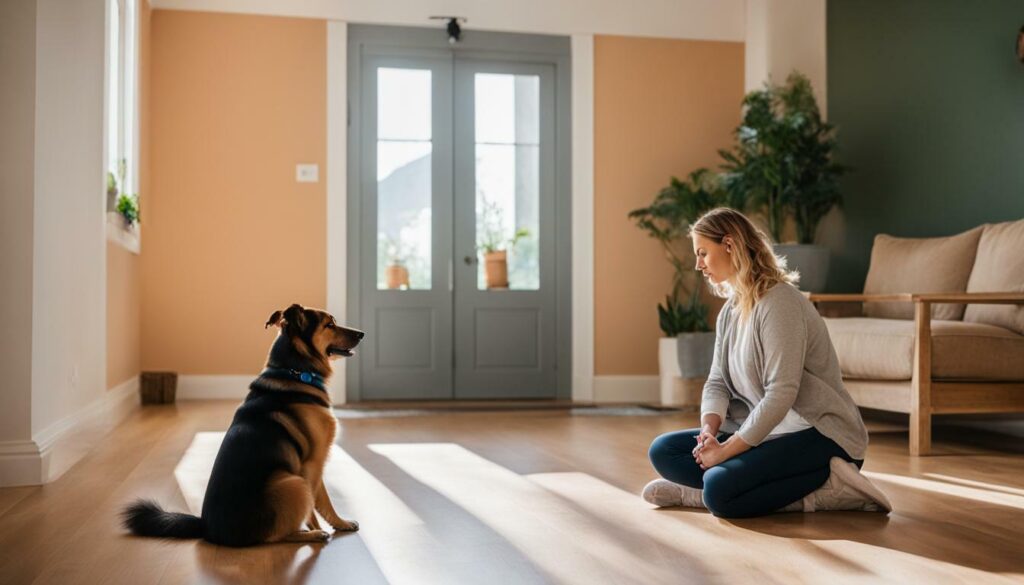
Lastly, always end training sessions on a positive note, with plenty of praise and positive reinforcement. This will help your dog to associate training with positive experiences, making them more motivated to continue learning and improving their anxiety detection skills.
Basic Training Foundations for Anxiety Detection
Before jumping into specific exercises for anxiety detection, it’s important to establish a foundation of basic training commands for your dog to follow. These commands will aid in your dog’s ability to detect and respond to anxiety cues.
Start with simple commands like “sit,” “stay,” and “come” to develop your dog’s listening skills. Use positive reinforcement, such as treats and praise, to reward your dog for following these commands correctly.
Once your dog has mastered these basic commands, move on to more advanced commands such as “heel” and “leave it.” These commands will help your dog focus on you and ignore distractions when needed.
Practice these basic commands regularly and in various settings to strengthen your dog’s obedience skills and prepare them for anxiety detection training.
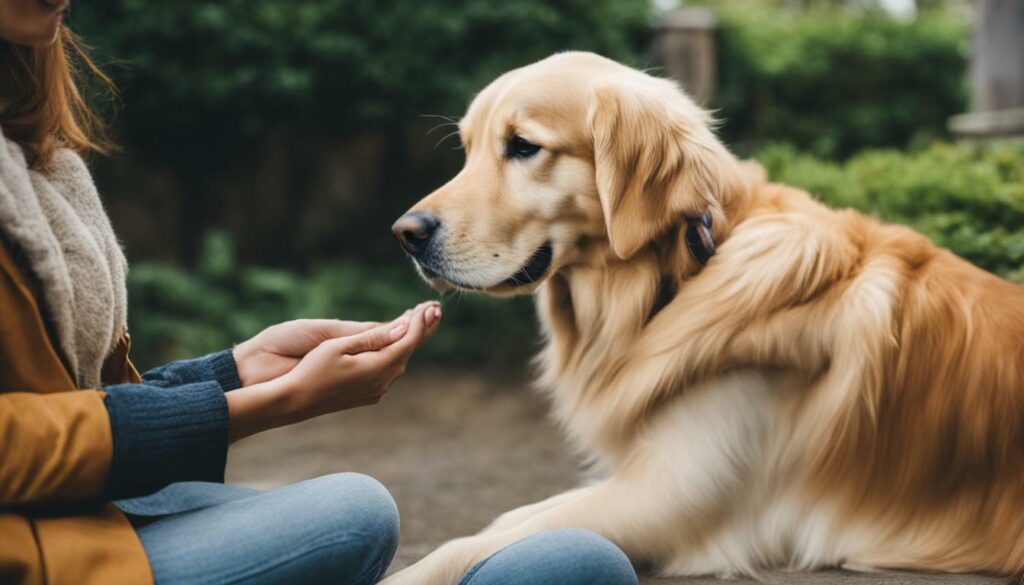
Incorporating basic training commands into your dog’s routine is an essential step in preparing them for anxiety detection training. By establishing a foundation of obedience, your dog will be better equipped to focus on and respond to anxiety cues.
Introducing Anxiety Scent Samples
Once your dog has a solid foundation in obedience training, it’s time to introduce them to anxiety scent samples. The process of introducing your dog to a new scent may take some time, so be patient and take things slow.
The first step is to obtain a scent sample associated with anxiety. This can be done by collecting a sample of your own scent when you’re feeling anxious, or by using a purchased anxiety scent sample. It’s important to avoid exposing your dog to the scent until you’re ready to begin the training process.
Begin by presenting the scent sample to your dog and allowing them to sniff it. Use a command such as “smell” to associate the new scent with a specific behavior. Repeat this process several times a day, gradually increasing the amount of time your dog spends sniffing the scent.
As your dog becomes more comfortable with the scent sample, you can begin hiding it around the house for them to find. Make it a game by using your “smell” command and rewarding your dog with a treat or praise when they successfully locate the scent.
Over time, your dog will begin to associate the scent with the specific behavior of sniffing and alerting you to anxiety. It’s important to keep the scent sample fresh and to store it in a sealed container to maintain its potency.
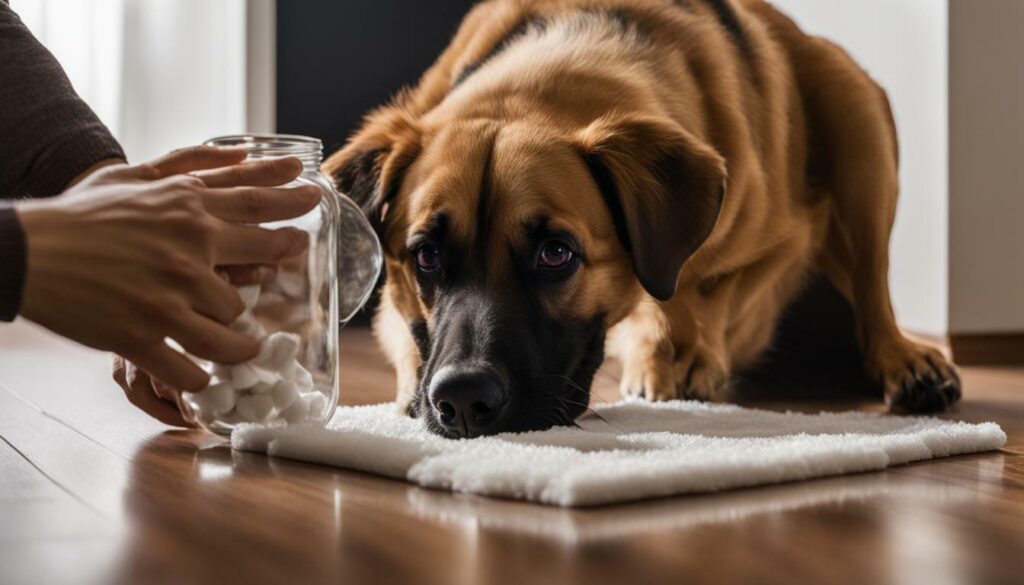
Introducing anxiety scent samples is an effective method for teaching a dog to detect anxiety. By gradually familiarizing your dog with the scent and associating it with a specific behavior, you can enhance their ability to detect anxiety and provide support when needed.
Associating Anxiety with Positive Rewards
Positive reinforcement is a crucial element of anxiety detection training. In this step, you’ll teach your dog to associate the detection of anxiety cues with rewards, motivating and reinforcing their behavior.
It’s important to use rewards that your dog finds highly desirable, such as small, tasty treats, or playtime with their favorite toy. This will ensure that your dog is excited to detect anxiety and motivated to continue their training.
To begin, start with a basic exercise. When your dog detects an anxiety cue, such as an increase in your heart rate or a change in your breathing, immediately reward them with a treat or playtime. Repeat this process consistently so that your dog begins to associate the anxiety cue with the reward.
Once your dog has mastered this exercise, move on to more complex scenarios. For example, if your dog detects anxiety when you enter a crowded room, reward them with a game of fetch or a special treat. Repeat this process consistently so that your dog learns that detecting anxiety in different environments is equally rewarding.
Remember, the key to effective anxiety detection training is consistency. Always use positive reinforcement to reward and motivate your dog, and continue practicing regularly to maintain and strengthen their skills.
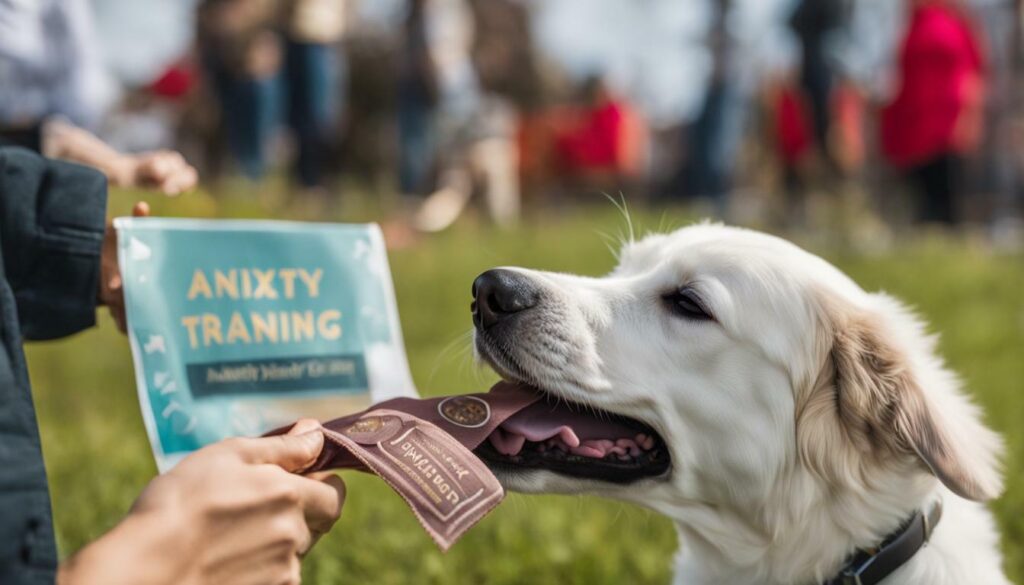
Now that your dog has a solid foundation in basic training commands and has become acclimated to anxiety scent samples, it’s time to move on to specific anxiety detection exercises.
Begin by introducing your dog to simulated anxiety triggers, such as deep breathing exercises or visual cues that indicate anxiety. Use a consistent signal to let your dog know when to begin detecting anxiety cues, such as saying “find anxiety.”
When your dog successfully detects anxiety cues, be sure to provide positive reinforcement, such as treats or praise. Repeat the exercises often to help solidify your dog’s ability to detect anxiety.
As your dog becomes more proficient in detecting anxiety cues, gradually increase the difficulty level of the exercises. For example, introduce anxiety triggers in new environments or situations to help your dog generalize their detection skills.
It’s important to remember that every dog learns at their own pace, so be patient and consistent with your training efforts. Consistency is key in helping your dog become a successful anxiety detection companion.
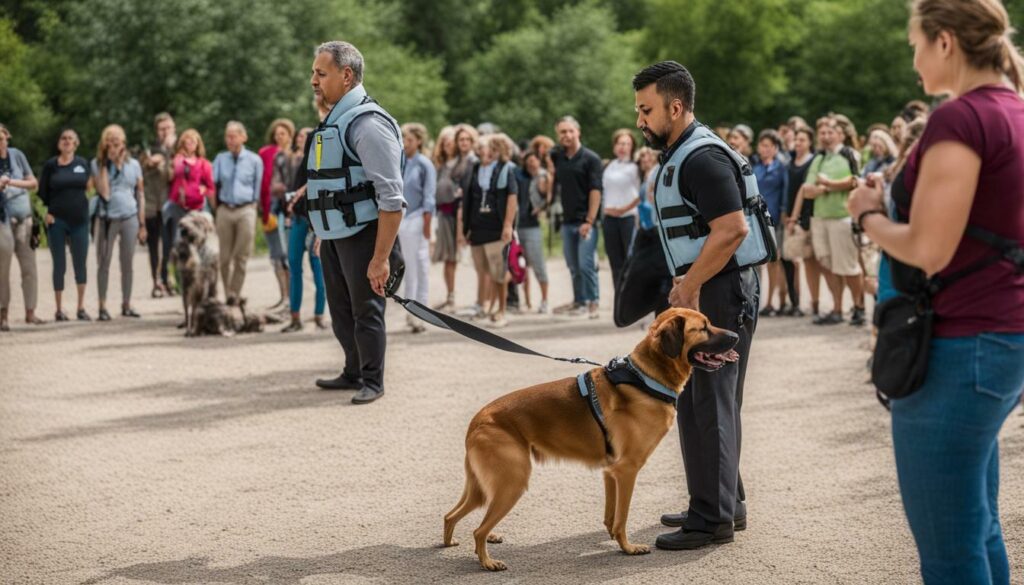
Once your dog has mastered the initial training exercises for anxiety detection, it’s time to fine-tune and generalize their skills. This means reinforcing their detection abilities in a variety of environments and situations beyond the training space, such as at home, in public, or in crowded areas.
To fine-tune your dog’s anxiety detection skills, repeat the training exercises in different settings. Start by practicing in a calm and familiar environment, such as your backyard or a quiet park. Gradually increase the level of distractions and noise to simulate real-life scenarios. This will help your dog build confidence and consistency in detecting anxiety cues.
It’s also important to generalize your dog’s detection skills by introducing new scents and anxiety triggers. This will help them recognize anxiety cues in unfamiliar and potentially stressful situations. For example, if your dog is mainly used to detecting your anxiety, introduce them to other family members’ anxiety scents and anxiety triggers.
Utilizing the skills you and your dog have developed will help keep your anxiety in check. In fact, you may find that simply having your dog around can help prevent anxiety from escalating in the first place.
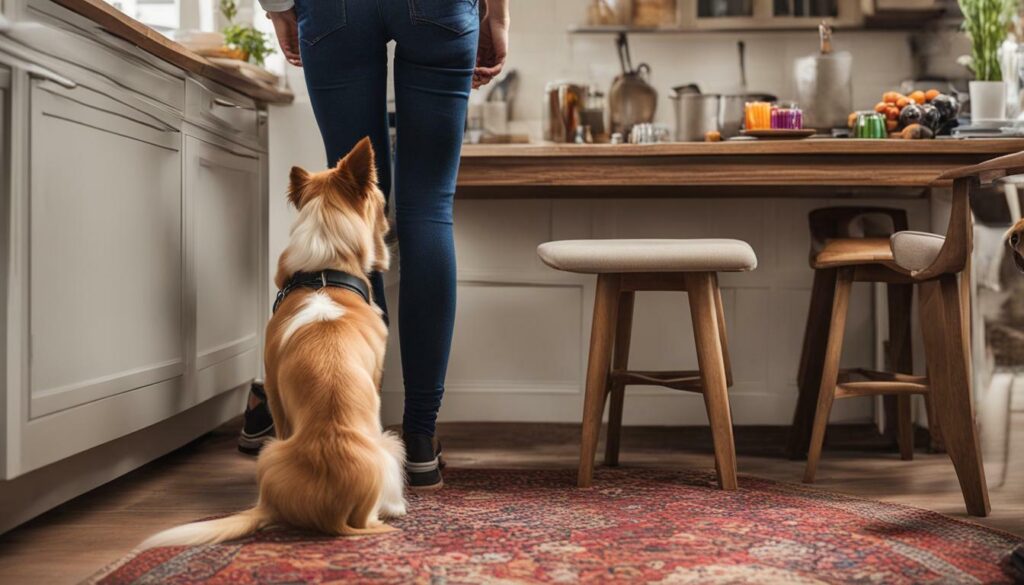
Make sure to stay patient and consistent with your training. Practicing regularly will reinforce your dog’s skills.
Troubleshooting Common Challenges in Anxiety Detection Training
Training a dog to detect anxiety can be challenging, but with patience and consistency, it can be achieved. Here are some common obstacles that you may encounter during the training process and effective methods for overcoming them.
Lack of Motivation
One of the biggest challenges in anxiety detection training is motivating your dog to detect anxiety cues. If your dog is not showing interest in the training, try using higher value rewards, such as their favorite treats or toys. It’s also important to ensure that your dog is mentally and physically stimulated and not tired or distracted during training sessions.
Inconsistent Training
Consistency is key in training, and inconsistency can lead to confusion and frustration for your dog. Make sure to establish a regular training schedule and stick to it. Avoid skipping training sessions or changing the routine too often. This will help your dog understand what is expected of them and stay motivated.
Slow Progress
Every dog is different, and some may pick up on anxiety cues faster than others. If you feel that your dog is progressing slower than expected, be patient and avoid pushing them too hard. Take a step back and review the basics of the training process. You may also consider seeking assistance from a professional dog trainer to help you fine-tune your training techniques.
Distractions
Dogs can easily get distracted, especially during training sessions. To minimize distractions, choose a quiet and isolated training location. You may also consider using a leash and collar or harness to help your dog stay focused. If your dog still gets distracted, try to redirect their attention back to the training task and reward them for their efforts.
Lack of Progress
In some cases, your dog may not be able to master anxiety detection training. If you feel that your dog is not making progress despite your best efforts, it may be best to consider alternative training techniques or seek advice from a professional dog trainer. Remember, every dog is unique, and it’s important to tailor your training techniques to your dog’s individual needs.
By anticipating potential challenges and having a plan to overcome them, you can ensure a successful anxiety detection training journey with your furry friend.
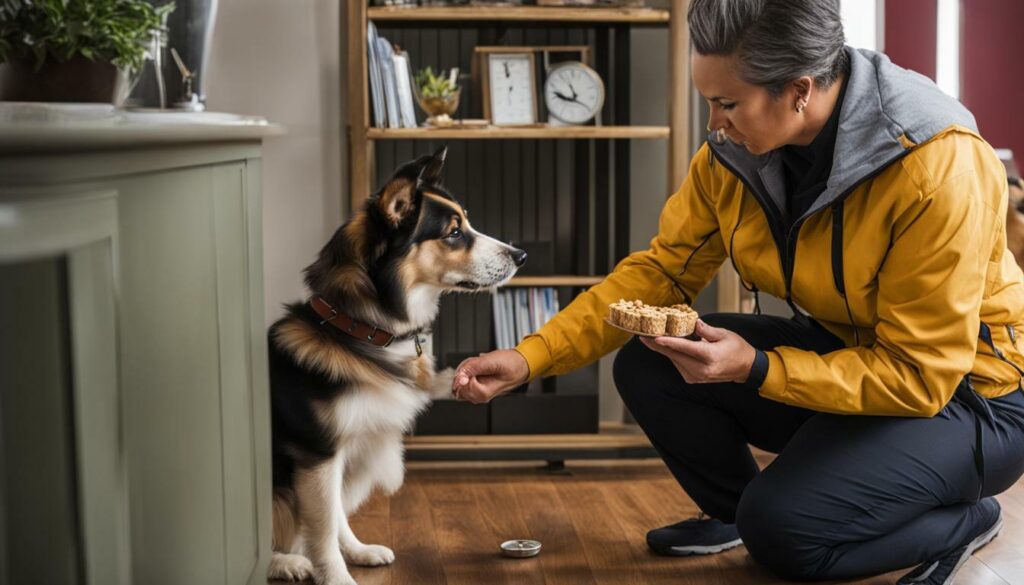
Training your dog to detect anxiety is a journey that requires patience, dedication, and consistency. It is essential to nurture and maintain the bond between you and your anxiety detection dog to ensure a successful partnership. Here are some tips on how to continue reinforcing your dog’s training and fostering a positive relationship:
- Regular reinforcement: Continue to reinforce your dog’s training by regularly practicing anxiety detection exercises. This will help to solidify their skills and keep them sharp.
- Positive interaction: Spend quality time with your dog engaging in activities such as playing, walking, or cuddling. This will foster a deeper connection and strengthen the bond between you.
- Continued training: Consistently train your dog on new anxiety detection exercises to further enhance their skills and confidence.
- Routine check-ins: Regularly check in on your dog’s emotional well-being and provide support if needed. This will help to maintain trust and open lines of communication between you and your dog.
The relationship between you and your anxiety detection dog is a two-way street. It is essential to provide them with the same love, care, and attention they provide you. By nurturing this bond, you will have a loyal and reliable companion for years to come.
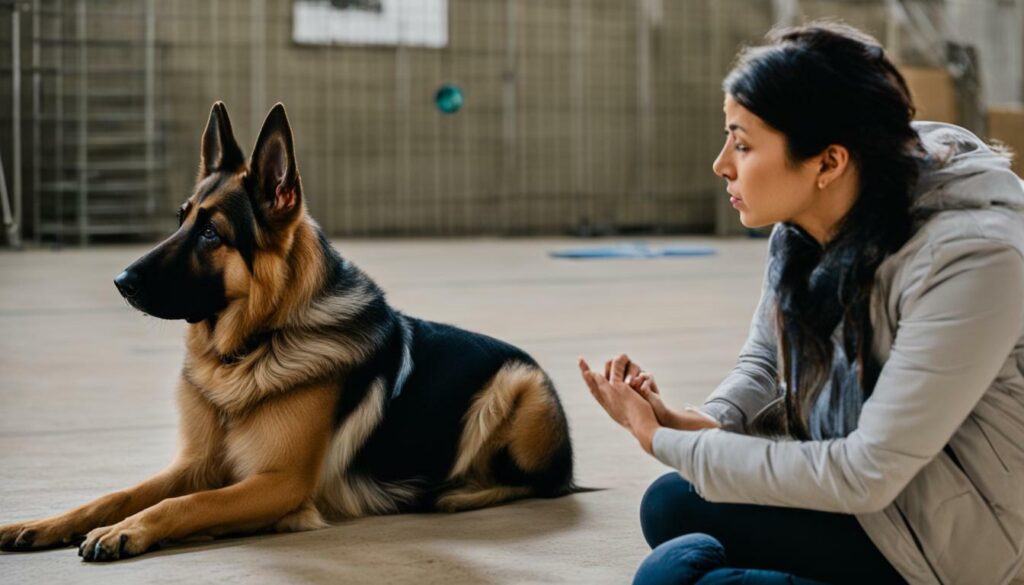
Now that your dog is trained to detect anxiety, it’s time to integrate their skills into your daily routine. Here are some effective methods for incorporating anxiety detection into your lifestyle:
Step 1: Recognize Your Triggers
Take note of what triggers your anxiety and share this information with your dog. By recognizing your specific triggers, your dog can provide support when you need it most.
Step 2: Practice Regular Training
Continue to practice anxiety detection training regularly to reinforce your dog’s skills. Even just a few minutes of training per day can make a big difference in maintaining their abilities.
Step 3: Utilize Your Dog’s Skills
If you feel anxious, take a moment to check in with your dog. If they’re displaying signs of detecting anxiety, such as nudging your hand or leaning against you, take a moment to breathe and refocus. Sometimes just the presence of your anxiety detection dog can be enough to calm you down.
Step 4: Enrich Your Dog’s Life
Don’t forget to continue enriching your dog’s life with plenty of exercise, mental stimulation, and affection. This will help maintain their overall well-being and strengthen the bond between you and your anxiety detection dog.
By following these steps and incorporating anxiety detection into your daily life, you can benefit from the invaluable support of your trained dog. Remember to continue nurturing your special bond and maintaining your dog’s skills to ensure a successful anxiety detection partnership.
FAQ
Q: How long does it take to train a dog to detect anxiety?
A: The duration of training can vary depending on the dog’s breed, age, and previous training experience. On average, it may take several weeks to a few months of consistent training to develop your dog’s anxiety detection skills.
Q: Can any dog be trained to detect anxiety?
A: While most dogs have the natural ability to sense emotions, not all dogs are suitable for anxiety detection training. Dogs with an excellent sense of smell, good focus, and a calm temperament tend to be more successful in this type of training.
Q: What are the benefits of training a dog to detect anxiety?
A: Training your dog to detect anxiety can provide emotional support and help you manage your own anxiety. Additionally, a well-trained anxiety detection dog can alert you to potential triggers, allowing you to take preventative measures and seek support when needed.
Q: How do I create a positive training environment for anxiety detection?
A: To create a positive training environment, ensure that both you and your dog are relaxed and free from distractions. Use positive reinforcement techniques, such as treats and praise, and keep training sessions short and frequent to maintain your dog’s engagement.
Q: What commands are essential for anxiety detection training?
A: Basic training commands, such as “sit,” “stay,” and “leave it,” form the foundation for anxiety detection training. These commands help your dog focus, stay calm, and respond to anxiety cues effectively.
Q: How can I introduce anxiety scent samples to my dog?
A: Introduce anxiety scent samples gradually by obtaining a sample from a person experiencing anxiety and allowing your dog to become familiar with the scent. Start by placing the scent sample in a controlled environment and gradually increase exposure as your dog becomes more comfortable.
Q: How do I associate anxiety detection with positive rewards?
A: Use positive reinforcement techniques, such as offering treats or praise, whenever your dog successfully detects anxiety cues. This association helps reinforce the desired behavior and motivates your dog to continue detecting anxiety.
Q: What training exercises can I do to enhance my dog’s anxiety detection skills?
A: Training exercises such as simulated anxiety scenarios, scent recognition games, and practicing response commands can enhance your dog’s ability to detect anxiety cues. Consistently engaging in these exercises will strengthen their skills over time.
Q: How do I troubleshoot common challenges in anxiety detection training?
A: Common challenges, such as distractions, lack of motivation, or difficulty generalizing skills, can be overcome with patience and persistence. Adjusting the training environment, using higher-value rewards, and gradually introducing new environments can help address these challenges.
Q: How do I maintain and nurture the bond with my anxiety detection dog?
A: Regular reinforcement through continued training, positive interaction, and engaging enrichment activities helps maintain and strengthen the bond between you and your anxiety detection dog. Regularly spend quality time together and reinforce their anxiety detection skills.
Q: How can I integrate anxiety detection into my daily life?
A: Integrating anxiety detection into your daily life involves recognizing your own anxiety triggers and relying on your dog’s detection skills to provide support. By incorporating regular training exercises and creating a routine that includes exercising, bonding, and relaxation, you can seamlessly integrate anxiety detection into your lifestyle.
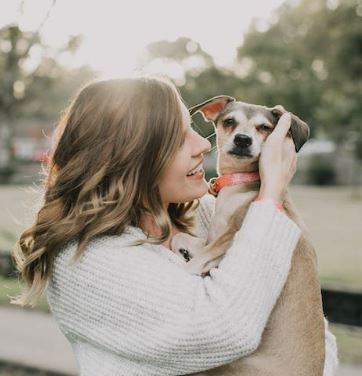
Marissa Delotta, 36, from Dayton, Ohio, is the creative force behind Roverboard.com, a beloved online destination for dog lovers. As a dedicated mom and canine enthusiast, Marissa combines her family experiences with her love for dogs to offer a platform where dog owners can exchange tips, heartwarming stories, and advice. Her website has become a vibrant community for sharing the joys of dog parenting. In her free time, Marissa enjoys exploring dog parks with her family and volunteering at local animal shelters.

